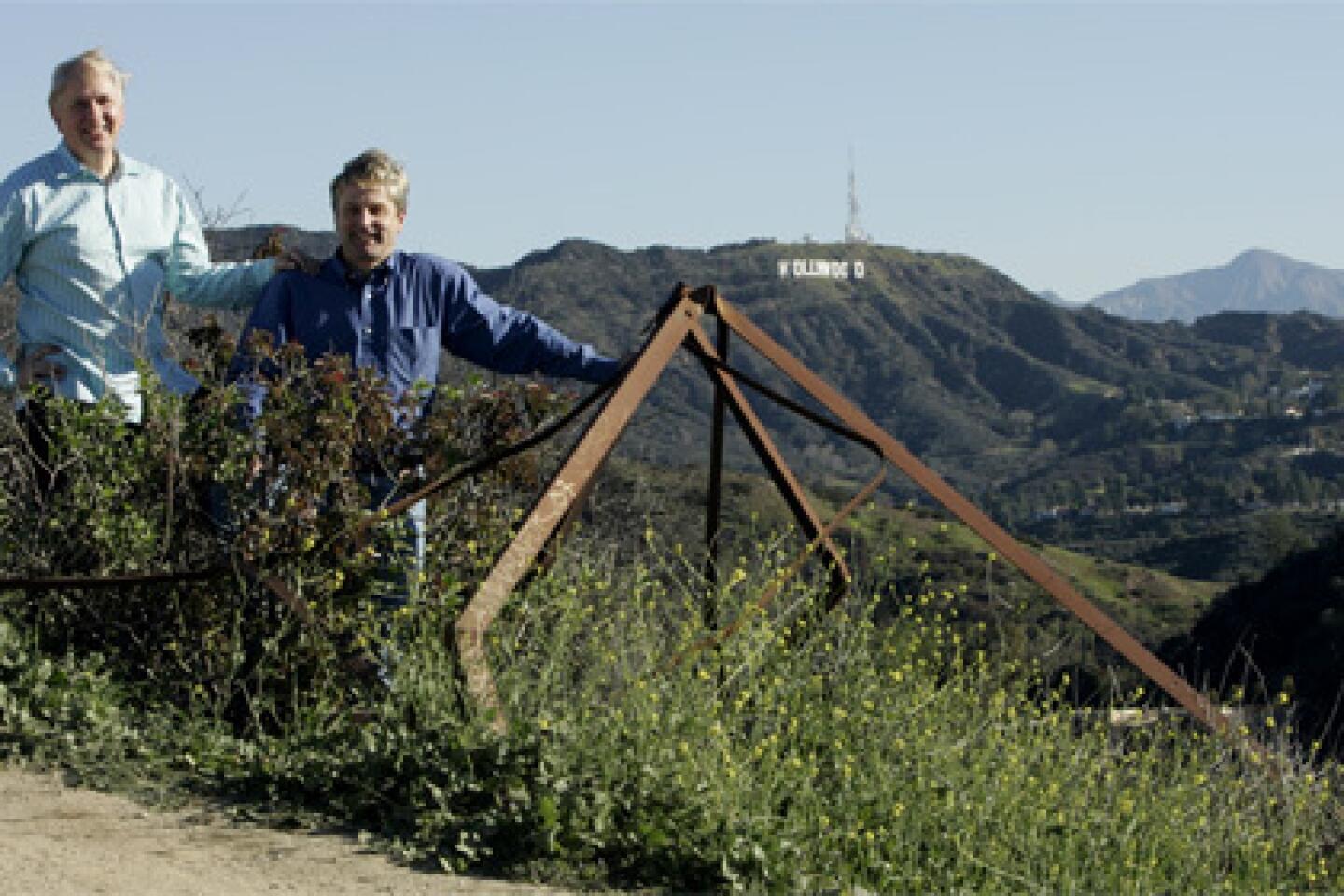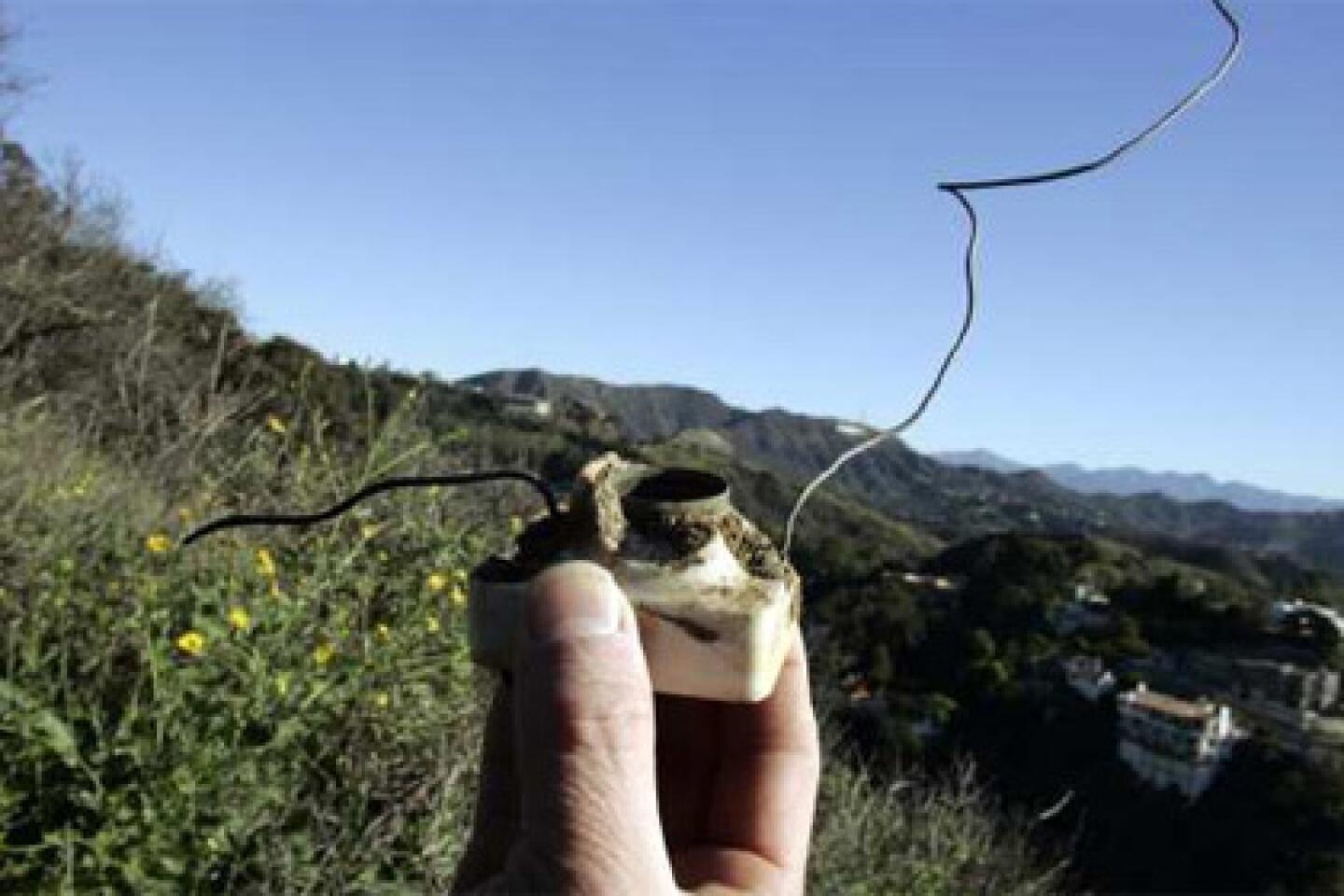Hidden Hollywood sign uncovers history
There’s the Hollywood sign everyone knows -- white letters 50 feet high, recognized the world over as the landmark of Tinseltown.
And then there’s the other Hollywood sign, the hidden one, whose red neon letters were once as familiar as the larger sign just across the canyon.
FOR THE RECORD:
Hidden Sign: The L.A. Then & Now column in the Feb. 17 California section said Gen. Harrison Gray Otis was The Times’ first publisher. Nathan Cole Jr. and Thomas Gardiner were the first publishers of the paper, in 1881. Also, the column identified Jesse Lasky as a movie director. He was a producer. —
The sign that read “Outpost” in neon letters 30 feet high was, like the original “Hollywoodland” sign, raised up to publicize a new housing development, Hillside Homes of Happiness.
It went up on the hilly terrain above Hollywood Boulevard’s Grauman’s Chinese Theatre in the late 1920s, designed to outshine the “Hollywoodland” competition. But by the beginning of World War II, it had vanished from sight and memory -- until the winter of 2002.
That’s when Outpost Estates residents and Runyon Canyon hikers Bob Eicholz and Steve Scott discovered the twisted wreckage of the rust-scarred steel letters and girders, covered by overgrown brush, and recognized it for what it was.
It was like archaeology come to life.
“We walked past the pile of steel every weekend, and all of a sudden a light bulb went off in my head,” Eicholz said in a recent interview. “I had heard of the Outpost sign, which according to folklore was one of the biggest neon signs in the world, and finally put two and two together, feeling like we had uncovered a secret.”
Some residents tried to find out whether the sign could qualify as a city historical-cultural monument but learned it wasn’t eligible because it was no longer standing. So it lies where Eicholz and Scott found it.
Outpost Estates is a pristine hillside community of roughly 450 homes. There were buildings on the land as far back as 1853, when Don Tomas Urquidez built Hollywood’s first adobe
“His house was smack dab in the middle of a sycamore grove near what is now Outpost Drive and Hillside Avenue,” Scott said.
Urquidez’s three-room adobe and the land, a former Indian burial ground, was the original birthplace of Hollywood as a performers’ town, where, more than 130 years ago, locals annually staged Los Pastores, or The Shepherds, a Mexican Nativity play. One of the now long-gone sycamore trees played a role in history here, too -- from its branches, at least 13 alleged horse thieves and bandits were hanged in acts of rough justice, according to Times archives.
Like many Spanish and Mexican landowners here, Urquidez failed to record his property title, and the land passed through a succession of owners. In the late 19th century, Gen. Harrison Gray Otis, a veteran of the Civil and Spanish-American wars and the first publisher of the Los Angeles Times, bought the otherwise undeveloped property and referred to the adobe as his retreat -- the Outpost. The Times building he called his Fortress, his staff the Phalanx, and his Wilshire Boulevard home the Bivouac. He soon built a more modern vacation home and clubhouse near the adobe as a retreat for his military friends and nature lovers. Los Angeles Arbor Day festivals and picnics for newsboys were held on the site.
Otis often boasted that the adobe was where the Treaty of Cahuenga was signed between Lt. Col. John C. Fremont and Gen. Andres Pico in 1847, ending hostilities in California between Mexico and the United States, and leading the way to California statehood.
But in 1917, a few weeks before Otis died, The Times printed a correction to many earlier stories that had made that claim, saying the statement was not “strictly accurate historically.” The Articles of Capitulation, which led to the cease-fire known as the Campo de Cahuenga Treaty, were signed in a farmhouse adobe at the foot of Cahuenga Pass, near what is now Universal City. A replica of the old adobe is now a city historical-cultural monument and a California historical landmark.
The Roaring 1920s were in full swing when Hollywood director Jesse Lasky bought as much as a dozen acres of Otis’ property for $157,000 -- land and both houses. But he never did anything with it. Flipping the property in 1924, he sold it to Hollywood real estate mogul Charles E. Toberman, a nephew of former Los Angeles mayor James Toberman, who envisioned “one of the most exclusive and beautiful parks in the world,” according to The Times.
Toberman kept the Outpost nickname on the land bordered by Mulholland Drive to the north, Franklin Canyon to the south, Runyon Canyon to the west and Cahuenga Boulevard to the east. He tore down the adobe and Otis’ retreat. Neon was still a novelty when he put up the “Outpost” sign about 1927 to attract buyers to the lots. They were small to two-acre estates and sold from $3,500 to $50,000; Toberman allowed only grand Spanish-style homes with tile roofs, a protection from raging brush fires.
Despite the 1929 stock market crash that ushered in the Great Depression, clients continued to build 5,000- to 10,000-square-foot homes with courtyards and fountains, terraced gardens, elaborate tile work and beamed ceilings. By 1931, actress Dolores Del Rio had built a house on the northwest corner of Hillside Avenue and Outpost Drive and had chopped down the hanging tree.
In 1935, Toberman shifted styles but not neighborhoods. He built an all-steel “termite free” house on a two-acre wooded estate on Outpost Drive. Actor Bela Lugosi, of the archetypal film “Dracula,” bought the home in 1936, five years after his vampire movie.
With the outbreak of World War II, the neon sign became a problem at a time when lights were routinely extinguished and windows covered for fear of attracting enemy bombers. The sign was dismantled, left where it had stood and remained forgotten for decades.
The sign was history when future TV game host Bob Barker and his wife, Dorothy Jo, arrived in Los Angeles.
“That was in 1950,” Barker said in a recent interview. “We stopped our car near Western and Los Feliz, looking out over the smog,” he said, “and my wife asked, ‘Barker, what have you gotten me into?’ ”
“She learned to cope,” Barker said.
Then, two decades later and a few miles away, the Barkers bought a 40-year-old Spanish Colonial Revival house, built on the site of that original adobe on the southwest corner of Hillside and Outpost.
“My wife loved this house, and when she was terminally ill she said she hoped it wouldn’t become an apartment house.”
In 1999, Barker, who still lives in the house, got the site declared a city historical-cultural monument because it had once held Hollywood’s first adobe.
“It’s on the regular tour bus schedule,” Barker said, “and I wave at the tourists all the time.”
More to Read
Sign up for Essential California
The most important California stories and recommendations in your inbox every morning.
You may occasionally receive promotional content from the Los Angeles Times.












